Our history
ANU is Australia's national university and has a unique history among Australian universities. Learn about our history, and how it continues to influence the work we do here today on the page below. Visit Heritage management to learn more about our well preserved heritage and principles.
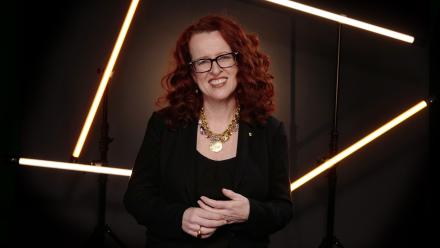
Distinguished Professor Genevieve Bell became Vice-Chancellor
Distinguished Professor Genevieve Bell AO FAHA FTSE became the 13th Vice-Chancellor and President on 1 January 2024.
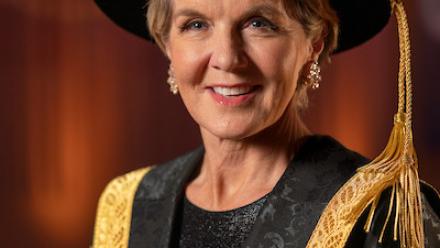
The Hon Julie Bishop became ANU Chancellor
The Hon Julie Bishop became Chancellor of ANU on 1 January 2020.
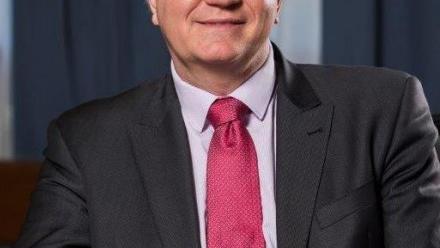
Professor Brian P. Schmidt became Vice-Chancellor
Professor Brian P. Schmidt AC FAA FRS became Vice-Chancellor on 1 January 2016.
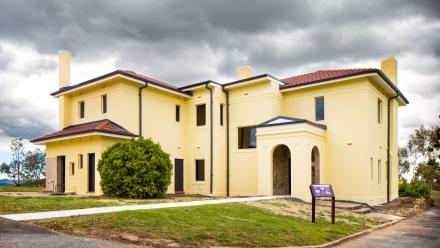
The Director's Residence is partially restored
The Mt Stromlo Heritage Trail is launched. The Director's Residence is partially restored.
Bushfire threatens Siding Spring Observatory
On 13 January 2013, the facility was threatened by a huge bushfire and firestorm. Eighteen staff were evacuated to Coonabarabran. Three buildings were destroyed: 'The Lodge' accommodation used by visiting researchers, the Director's Cottage and the Fire Station. Bushfire prevention measures had been implemented and were credited with the protection of the telescopes. Since this time ANU has been undertaking a program of rebuilding at the site, restoring much of its lost functionality. Several of the damaged buildings are now managed as ruins and stand as a stark reminder of the fire. Optical astronomy is no longer undertaken at this site, however recent development of the site's manufacturing and industrial capabilities ensure the site is a thriving and world class research centre.
Nobel Prize in Physics
Mt Stromlo's Professor Brian Schmidt and his research partners are awarded the 2011 Nobel Prize in Physics.

Partnership to build the Giant Magellan Telescope in Chile
Mt Stromlo astronomers and engineers join an international partnership to build the Giant Magellan Telescope in Chile.
The Great Daylight Comet
Every few years a comet becomes bright enough to be easily seen with the naked eye. The discovery of C/2006 P1 on Aug 7, 2006 was a significant event, as this comet is considerably brighter than Halley’s Comet. The comet was discovered with the Uppsala Schmidt telescope at Siding Spring Observatory.

First phase of the Advanced Instrumentation Technology Centre (AITC) completed
In 2006, the first phase of construction is completed on the Advanced Instrumentation Technology Centre (AITC) which will continue the design and manufacturing of astronomical instruments.
Forming seven ANU Colleges
The formation of seven ANU Colleges, grouping together Research Schools, Faculties and Centres.
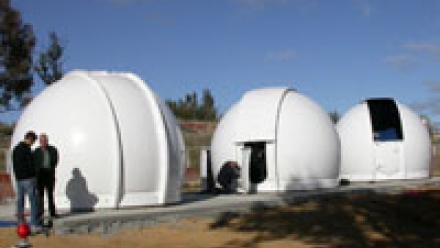
Telescopes for visitor outreach
Three small telescopes with domes are constructed in 2005 on the site of the former Workshops for use in visitor outreach.
The National Institute of the Arts join with the ANU
The National Institute of the Arts (NITA) amalgamates with the Faculty of Arts.
Medical School opens to students
The ANU Medical School is accredited by the Australian Medical Council for the first intake of students.

Bushfires severly impact Canberra and the ANU
On 18 January, Mt Stromlo Observatory is devastated by bushfire. Telescopes, workshops, the original Observatory Building, the Director's Residence and many of the original houses are destroyed, and the Weston research facilities are severely.
Restructuring the University
In June the ANU Council announces a major restructure of University governance including the creation of Deputy Vice-Chancellors for Research and Education and the establishment of twelve virtual National Institutes
Start of the National Field Robotics Facility
A joint venture between ANU and the Universities of Sydney and Wollongong establish the National Field Robotics Facility at Spring Valley Farm.
Evidence that the Universe is expanding at an accelerating rate
Following observations of supernovae, Mt Stromlo researcher Brian Schmidt (along with two other astronomers from the United States) publishes evidence that the Universe is expanding at an accelerating rate.

The Satellite Laser Ranger Observatory is installed on Mt Stromlo
The Satellite Laser Ranger Observatory is installed on Mt Stromlo. It is built and operated by Electro Optic Systems Pty Ltd for Geoscience Australia.
The University welcomes new additions
The University Archives is established. The Mount Stromlo and Siding Spring Observatories become the Research School of Astronomy and Astrophysics (RSAA). The Asia Pacific School of Economics and Management (later Government) is established.
University's 50th anniversary
ANU celebrates its 50th anniversary with a program of academic and social events.
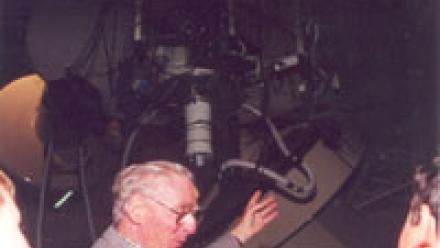
Opening of the Mt Stromlo Visitor's Centre
The Mt Stromlo Visitor's Centre or 'Exploratory' is opened.
New centres are established
In the Institute of Advanced Studies, the Research School of Information Sciences and Engineering (RSISE) is established. The Centre for Middle Eastern and Central Asia Sudies (from 1999, the Centre for Arab and Islamic Studies) is established in the Faculty of Arts.
ANU astronomers discover expanding universe
Perhaps the greatest astronomical contribution was the discovery that the universe is expanding at an accelerating rate. Professor Brian Schmidt formed the High-Z Supernova Search Team in 1994 to observe the characteristics of stellar explosions – or supernovae. Some work for this project was undertaken using the AAT and the ANU 2.3m Telescope.
Opening the Faculty of Engineering and Information Technology
In the Faculties, a new Faculty of Engineering and Information Technology is established.
The Canberra Institute of the Arts joins with the ANU
The Canberra Institute of the Arts, comprising the Canberra School of Music and the Canberra School of Art, amalgamates with ANU.
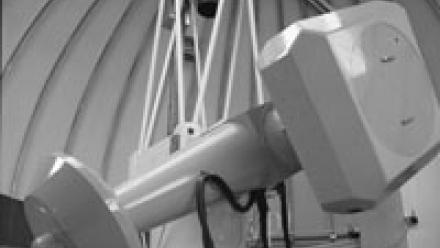
Attempt to solve the mystery of 'dark matter'
Mt Stromlo embarks on the MACHO (Massive Astronomical Compact Halo Objects) project, in an attempt to solve the mystery of the Universe's missing mass 'dark matter'.
Changes for the Research School of Physical Sciences
The Research School of Physical Sciences becomes the Research School of Physical Sciences and Engineering (RSPSE).
Establishing the ANU Graduate School
The ANU Graduate School is established, intended to coordinate graduate teaching and resources across the University and to provide greater cohesion between the Institute of Advanced Studies and the Faculties.
Establishment of the ANU Supercomputer Facility
The University purchases a 'Fujitsu FACOM VP50 vector processor' and establishes the ANU Supercomputer Facility to house it.
Mt Stromlo and Siding Spring Observatories become independent centres
Mt Stromlo and Siding Spring Observatories separate from the Research School of Physical Sciences to become independent centres within ANU. Prime Minister Bob Hawke and other dignitaries visit Mt Stromlo to observe the close approach of Halley's Comet.
A new telescope for the observatory
A new 2.3 metre telescope is opened at the Siding Spring Observatory, which was closely linked with the Department of Astronomy in the Research School of Physical Sciences.

Bob Hawke opens the University's largest telescope
The Prime Minister, Bob Hawke, opened the University's largest telescope at Siding Spring Observatory.
The oldest star is discovered
Stromlo scientists Mike Bessell and John Norris discover the oldest star, a record which stands for over 20 years. The same team reclaimed this title in 2014.
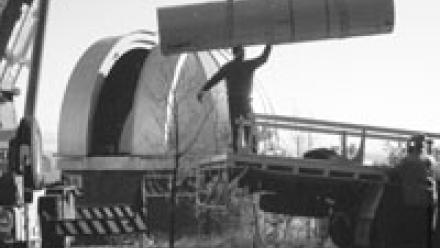
Uppsala Schmidt telescope moves
Uppsala Schmidt telescope moves to Siding Spring Observatory.
Renaming the School of General Studies
The School of General Studies formally renamed The Faculties.
Opening the Women's Studies Program
After extended debate, a separate Women's Studies Program in the Faculty of Arts came into being.
Purchase of the Spring Valley Farm
Spring Valley Farm is purchased by ANU to operate as an Animal Science Field Laboratory for the John Curtin School of Medical Research.
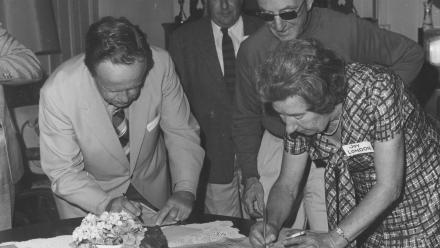
Establishment of the Kioloa Coastal Campus
Miss Joy London bequeathed the 348 hectare property to ANU on 1 March 1975.
The Humanities Research Centre is established
The Humanities Research Centre (HRC) is established as another important 'centre' in the University.
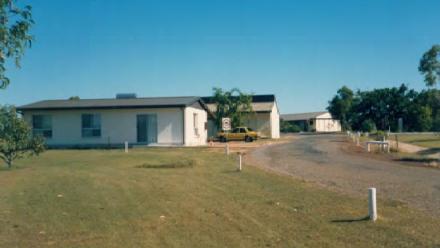
Establishment of the North Australia Research Unit
The North Australia Research Unit (NARU) was established in 1973 to specialise in research in northern Australia and to provide a base and logistic support for ANU and other Australian and overseas institutions undertaking research in northern Australia.
Establishing the Centre for Resource & Environmental Studies
The Centre for Resource and Environmental Studies (CRES) is established, part of a trend to establish what was sometimes referred to as a 'third dimension', namely units and centres within the University
Separating departments
A decision is made to create a separate Research School of Earth Sciences (RSES) from departments in the Research School of Physical Sciences.
Commonwealth Time Service departs
In 1968, the Commonwealth Time Service departs the Mount Stromlo Observatory.
Opening the Computer Centre
The Computer Centre was established, intended to serve users campus wide.

Establishment of the Warramunga Seismic & Infrasound Station
A twenty element seismic array was established at the site in 1968 and has been operated by ANU since then. Today the site also operates a WRAB Broadband Seismometer on behalf of the University of California, San Diego and an Infrasound Array which has operated since the early 1970s.

Opening new research schools
The Research School of Chemistry (RSC) and the Research School of Biological Sciences (RSBS) are established bringing the number of research schools to six.
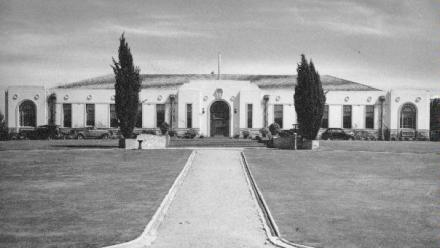
The Australian Forestry School accepts its first students
The Australian Forestry School, which had been established in Canberra since 1927, accepted its first students as a department in the ANU Faculty of Science.
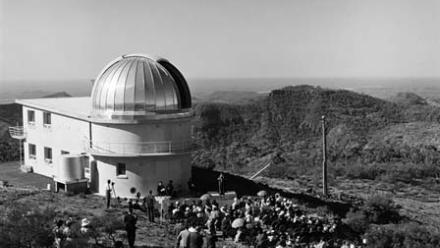
Siding Spring Observatory officially opens
Siding Spring Observatory was officially opened on 5 April 1965. The University had set up three telescopes, together with supporting facilities such as sealed roads, staff accommodation, electricity and water.
Flooding in Lake Burley Griffin
Lake Burley Griffin is flooded, skirting the southern edge of the ANU campus
First building constructed at Siding Spring Observatory
The first building constructed on the site was the 40-inch Telescope.

Appointing the first female professor
Hanna Neumann is appointed the University's first female professor, as Professor of Mathematics in the School of General Studies.
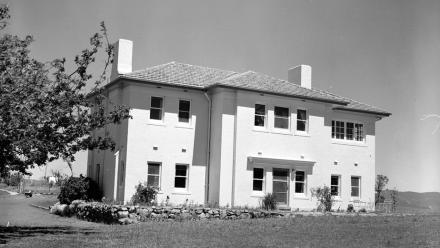
Duffield Building completed
The Duffield Building is constructed to accommodate research students and staff at Mount Stromlo Observatory.
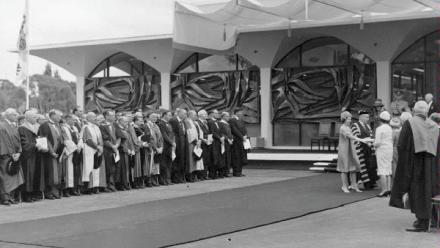
New libraries are opened
The two University Library Buildings are opened, the R G Menzies Building and the J B Chifley Building.
Siding Spring becomes a field station
The growth and sprawl of Canberra, ACT, developed rapidly and it was in the late 1950s that artificial lights from the nearby suburbs began to impact upon the observational capacity of the Mt Stromlo Observatory. In May 1962, the final decision was made by the ANU Vice-Chancellor Leonard Huxley that Siding Spring would become the site for the field station.
Establishing the Faculty of Oriental Studies
The School of General Studies establishes a new faculty, the Faculty of Oriental Studies. In 1970, it became the Faculty of Asian Studies.
Reaching New Guinea
The New Guinea Research Unit, part of the Research School of Pacific Studies, begins operations with a small group of support staff and academics located in Canberra and New Guinea. The Unit fostered interdisciplinary work on New Guinea among ANU academics.
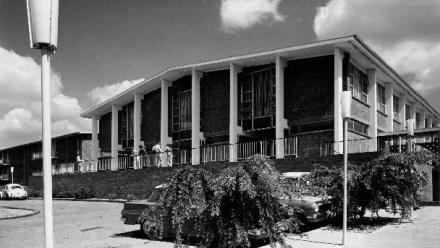
Residents occupy Bruce Hall
Bruce Hall, the first residential hall for undergraduate students on campus, is occupied.
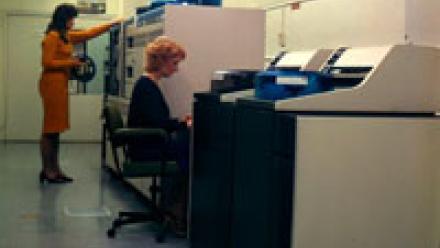
First computer used at ANU
An IBM 610 computer is rented to assist in the analysis of data. It is the first computer to be used by ANU.
Canberra University College becomes ANU
ANU amalgamates with Canberra University College. CUC becomes the School of General Studies at ANU and undergraduates become part of ANU life for the first time. In 1960 ANU still had its four central research schools, the John Curtin School of Medical Research (JCSMR), the Research School of Physical Sciences (RSPhysS), the Research School of Social Sciences (RSSS) and the Research School of Pacific Studies (RSPaS), while the School of General Studies had Faculties of Arts, Economics, Law and Science.
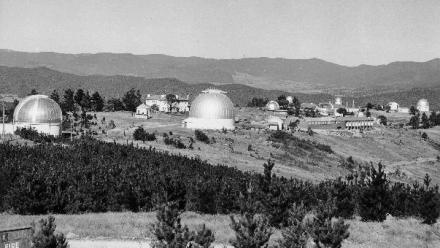
Mt. Stromlo Observatory joins the ANU
The Australian National University through association with the Department of Astronomy in the Research School of Physical Sciences assumes control of the Mount Stromlo Observatory from the Department of the Interior, and the name is formally changed to Mount Stromlo Observatory. Bart Bok is appointed Director of the Observatory, and Head of the ANU Department of Astronomy.
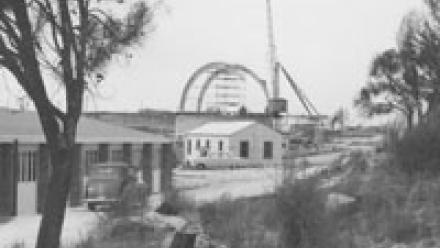
New telescopes in operation
The 26-inch Yale-Columbia Telescope and Stromlo's largest telescope, the 74-inch reflector, commences operation. In conjunction with the University of Uppsala in Sweden, the Uppsala Schmidt telescope is erected at Mt Stromlo.
Celebrating twenty-five years
Canberra University College celebrates its twenty-fifth anniversary.
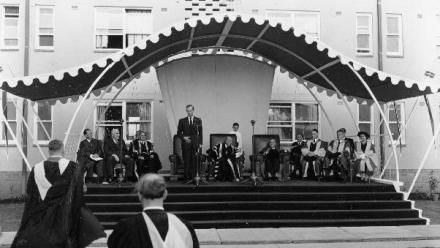
University House opens
In February 1954, University House is officially opened.
Forming the Archives of Business and Labour
Noel Butlin, an economic historian in the Research School of Social Sciences, begins collecting Australian business records, which come to form the basis of the University's Archives of Business and Labour (now the Noel Butlin Archives Centre).
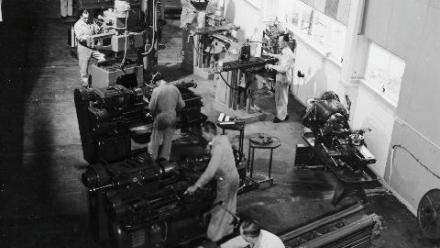
The laboratories for the Research School of Physcial Sciences are opened
The laboratories for the Research School of Physical Sciences, the University's first permanent buildings, are opened.

Bushfire attacks Mt Stromlo
In February, a bushfire attacks Mt Stromlo, workshops and part of the Commonwealth Solar Observatory (CSO) building are destroyed.
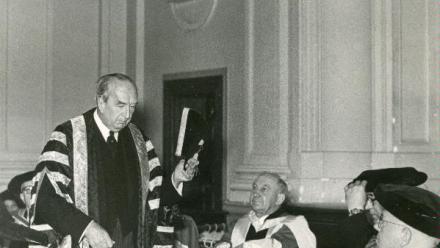
The first Chancellor
The University's first Chancellor, Lord Bruce, is installed.
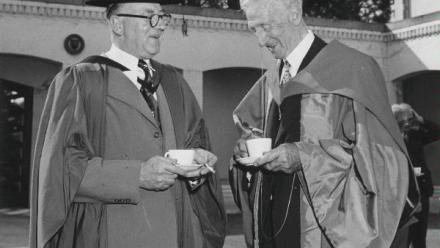
Conferring the first degree of Honorary Doctor of Laws
On the 7th of December 1951, the ANU confers its first degree of an Honorary Doctor of Laws on Sir Robert Garran, one of the authors of the Australian Constitution and a long-time advocate of university education in Canberra.
First meeting of the ANU Council
12th of July 1951- First meeting of the ANU Council, which succeeded the Interim Council appointed in 1946.
Marking 50 years of Federation
From July to September of 1975, a series of seminars on science, Commonwealth-State relations and federalism held to mark 50 years of Federation.
The arrival of academic staff members
The first academic staff members arrive to take up their appointments at ANU. At this time, there were few buildings to house them.
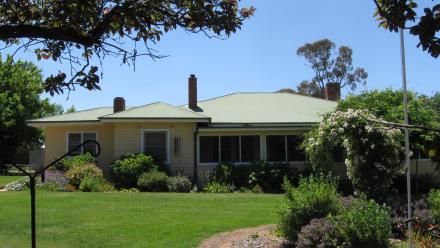
Beginnings of the Spring Valley Farm
The homestead on the site was said to have been constructed in 1949, and several of the outbuildings were constructed during the 1950s, being used as a pastoral property before ANU purchased the property.
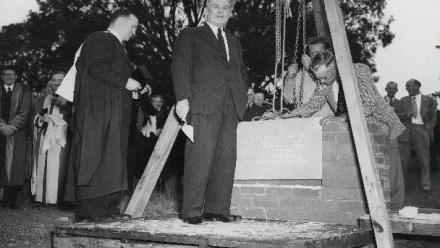
Laying the foundations of the John Curtin School of Medical Research
24 October 1949 - Foundation stones for the John Curtin School of Medical Research, the Research School of Physical Sciences and University House laid by Ben Chifley, Prime Minister and John Dedman, Minister for Post-War Reconstruction.
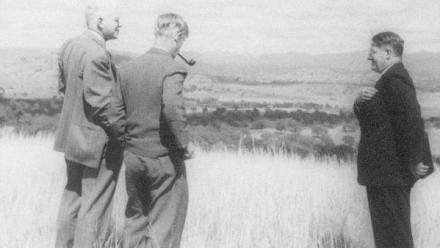
Shaping the University
In Easter of 1948, significant meetings occur between the Interim Council and the Academic Advisory Committee, consisting of Florey, Hancock, Oliphant and the anthropologist Raymond Firth on the shape the national university was to take. The meetings took place in the Institute of Anatomy Building, which now houses ScreenSound Australia, the National Screen and Sound Archive.
The first librarian
The University's first librarian, A L G McDonald, was appointed to begin gathering together the University Library's collections.
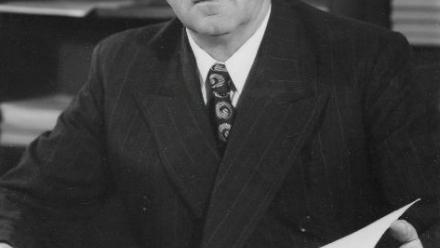
The first Vice-Chancellor
In March of 1948, Sir Douglas Copland was appointed as the first Vice-Chancellor of the University.
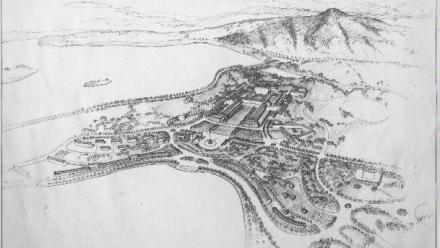
Designing the University
In late 1947, Brian Lewis, Professor of Architecture at the University of Melbourne was appointed Consulting Architect to design the University's major buildings.
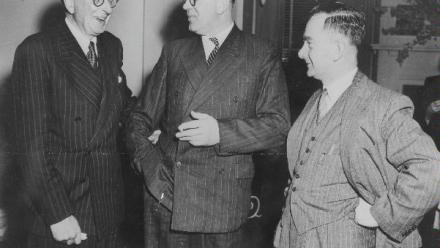
The Interim Council of the University's first meeting
In September of 1946, the first meeting of the Interim Council of the University took place in the Senate Committee Room in Parliament House.
Involving prominent academics
In April of 1946, H C Coombs meets with prominent academics in England, some of them Australian expatriates, including the medical scientist Sir Howard Florey, the historian W K Hancock and the physicist Mark Oliphant, to discuss the proposed Australian National University.
Passing the Bill by Federal Parliament
On the 1 August 1946, the Bill establishing The Australian National University is passed by Federal Parliament.
Establishing a National University
From late 1944 to 1945, discussions between intellectuals and administrators, including H C 'Nugget' Coombs, Alfred Conlon, and Roy Douglas 'Pansy' Wright set the scene for the establishment of a National University.
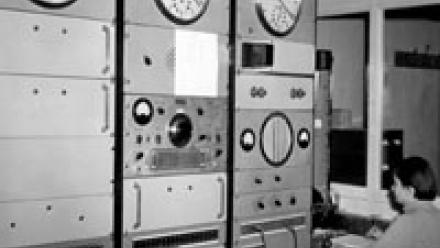
Commonwealth Time Service and the Great Melbourne Telescope acquired
The Observatory begins the construction of the dome for the Great Melbourne Telescope. Director Woolley shifts the focus from solar to stellar astronomy. He begins negotiations to acquire more suitable telescopes.
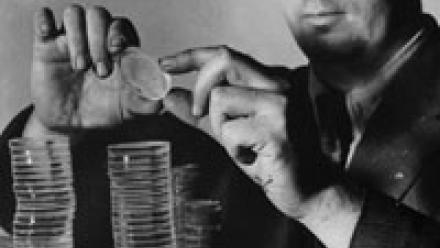
Impact of the Second World War on Mt Stromlo Observatory
The Second World War dramatically changes the role of the observatory. The Commonwealth Solar Observatory operates Optical Munitions Factory, designing and manufacturing gun-sights and other equipment to aid the war effort. The Observatory swells in size - a number of new workshops are constructed, and the staff numbers grow from 10 to 70.

Heliostat (Sun Telescope) completed
The Heliostat (Sun Telescope) is completed. Telescope is used by Clabon Allen in analysing stellar spectra and developing Solar Atlas.
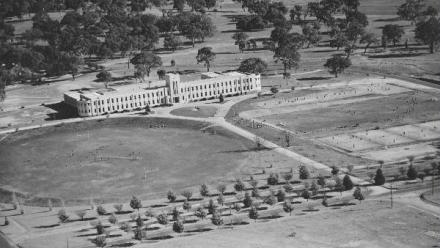
Canberra University College enrolls its first students
Canberra University College, which later amalgamated with The Australian National University, enrolled its first students. Canberra University College was established with a loose association with the University of Melbourne.
Mount Stromlo director commemorated
W.G. Duffield is struck with influenza and dies on 1 August at Stromlo. He is buried on the ridge, beyond the Oddie telescope. Bill Rimmer is appointed Officer-in-charge.
Reynolds Telescope
The 30" Reynolds Telescope is completed, becoming Stromlo's first reflecting telescope, and the largest operational telescope in the southern hemisphere.

Construction of the Director's residence
The Director's residence is completed, and the Duffield family moves in.
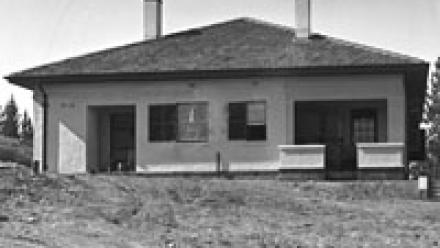
Staff relocation
Observatory staff relocate to Mt Stromlo as the residential buildings are completed.
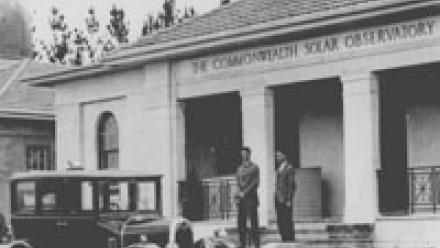
Main CSO building completed
The main Commonwealth Solar Observatory (CSO) building is completed. The astronomers begin moving equipment from the Observatory's temporary housing within the Hotel Canberra.
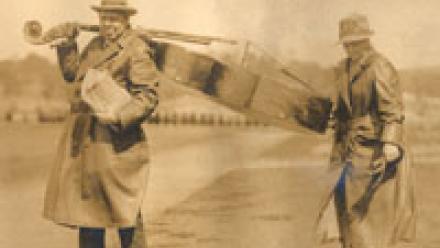
Commonwealth Solar Observatory established
The Federal Government confirms the establishment of Mt Stromlo as the Commonwealth Solar Observatory (CSO). Duffield is appointed as the CSO's first director. The original interests of the CSO were focussed on solar and atmospheric physics.
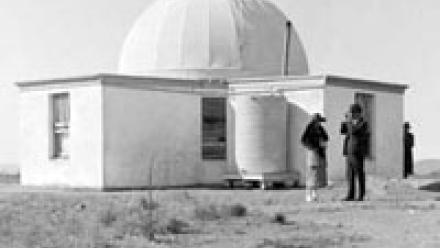
Stromlo's first residents
Meteorological observer J.C Cotterill and his family move into the Oddie Dome in 1920, becoming Stromlo's first permanent residents.
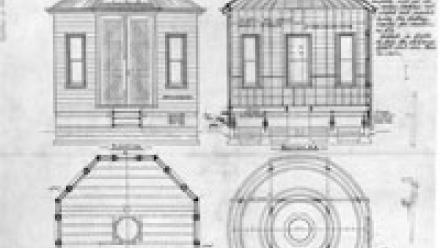
First World War
The First World War hinders the development of the Mount Stromlo Observatory.
Agreement to establish Mt Stromlo as the Commonwealth Observatory
In 1913, following test observations, Government Astronomer Pietro Baracchi praises the conditions of the site, and the federal government provides an 'in principle' agreement to establish Mt Stromlo as the Commonwealth Observatory.
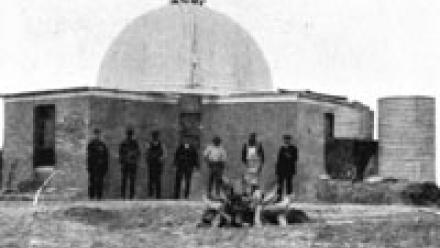
The Oddie Dome
In 1911, the first observatory building is constructed to test the suitability of the Mt Stromlo site. The Oddie Dome is the first Federal building to be constructed in the ACT.
The National Capital
Following the resumption of the land by the Commonwealth in 1911/12 - the Acton Campus site was earmarked as the early administrative hub of the newly proclaimed Federal Capital Territory - encompassing offices and residences of the fledgling Commonwealth Public Service, the residence of the Administrator and the Canberra Community Hospital (1914). However the site was always envisioned as an educational precinct. In the original design competition for Canberra (1911) - Walter Burley and Marion Mahony Griffin's winning competition entry designated the site for tertiary learning, even going as far as plotting the locations of individual disciplines.
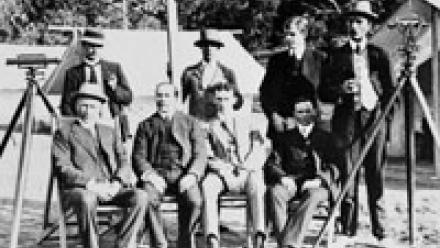
Mt Stromlo as potentially suitable site
With support from the Commonwealth Government, Mt Stromlo is tentatively chosen as a potentially suitable site for an Observatory.
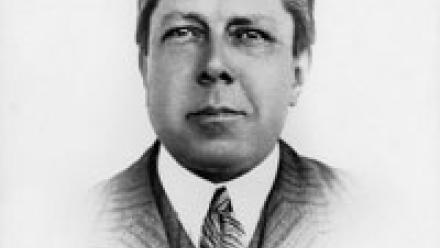
Plan to establish a solar observatory in Australia
Walter Geoffrey Duffield first identifies the opportunity for an Australian solar observatory in 1905. In 1908 he returns from his studies in England and a 'Solar Research' conference in Oxford with the plan to establish a solar observatory in Australia.
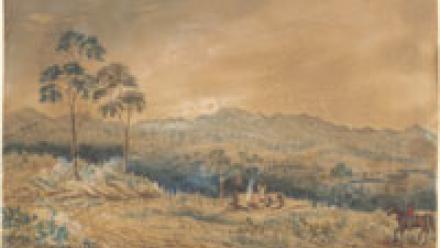
Pastoral settlement
Following European settlement in Australia, the area of the Acton Campus was largely transformed by heavy pastoralisation from the 1820s, with two properties - Springbank and Acton, occupying the site. Livestock and cropping markedly changed the open grassland character of the site, and the first modern buildings appeared in the area in the form of homesteads and pastoral outbuildings.
Past Chancellors
- Professor the Hon Gareth Evans AC QC FASSA FAIIA ( - )
- K C Beazley AC ( - )
- A D Hawke AC ( - )
- Peter Erne Baume AC HonDUniv ( - )
- Sir Geoffrey Yeend ( - )
- Sir Gordon Jackson ( - )
- Sir Richard Blackburn ( - )
- Sir John Crawford ( - )
- H C Coombs ( - )
- Lord Howard Florey OM FRS FRCP ( - )
- Sir John Douglas Cockcroft HonDSc ( - )
- Lord Bruce ( - )
Past Vice-Chancellors
- Professor Brian P. Schmidt AC FAA FRS ( - )
- Professor Ian Young AO ( - )
- Ian William Chubb AC HonDUniv ( - )
- R D Terrell AO ( - )
- L W Nichol ( - )
- P H Karmel AC CBE ( - )
- D A Low ( - )
- R M Williams ( - )
- Sir John Crawford ( - )
- Sir Leonard Huxley ( - )
- Sir Leslie Melville ( - )
- Sir Douglas Copland ( - )